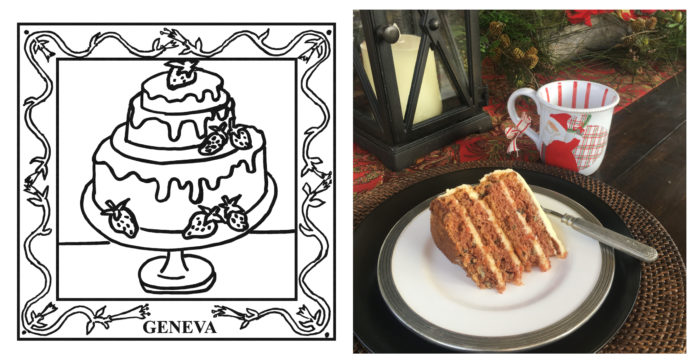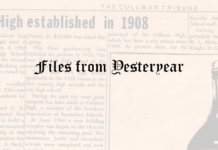
The Cullman Tribune is celebrating the Alabama Bicentennial (1819-2019) with statewide field reporting by Alabama Master Gardener/Botanical Artist Ben Johnson South. This year-long feature, “The 67-County Alabama Garden Party,” will spotlight different counties each week. Each county will get its own “quilt block,” along with a historical profile, and we’ll share a recipe specific to the area. At the end of the year, all 67 counties will be put in a book to commemorate the Bicentennial.
Geneva County
“History is written by the victors,” is a quote attributed to Napoleon Bonaparte. It is as true of victorious environmentalists as it is of militarists.
The 67-County Alabama Garden Party, this county-by-county exploration, celebrates how “positive and pleasurable PLANTS + PEOPLE” have come together over the last 200 years. So, here in Geneva County, a coastal plains area that shares a border with Florida, we can look with hope to successful efforts reviving parts of the native longleaf pines (Pinus palustris) and the dominant understudy of herbaceous wiregrass (Aristida beyrichiana).
Geneva County plant enthusiasts have reason to be hopeful about the efforts of the Longleaf Alliance to conserve and restore the dwindling longleaf pine ecosystem, including the wiregrass. The Gulf Coastal Plain Ecosystem Partnership, which is part of the Alliance, was formed in 1996 with seven public and private landowner partners and enrolled 840,000 acres. Today, there are 13 partners actively restoring, protecting and managing more than 1.25 million acres. You can read more about these environmental activists at their informative website: www.longleafalliance.org.
Geneva County was established in 1868. By 1930, most of the longleaf pine ecosystems in Alabama had been forested. About half the state, excluding the Black Belt delta and areas north, were in this ecosystem. Longleaf pine thickets could even be found in the most northern counties in the dry ridgetops.
The wiregrass and longleaf pines in Geneva County were supplanted by agriculture and timbering interests, as well as by fire suppression. Fire is essential for the reproduction of these plants. Every part of a longleaf pine forest is adapted for fire, including plant flowering and seeding, and for the nesting of ground-dwelling birds.
Famed plant explorer William Bartram described the wiregrass and longleaf pines in his writings when he traveled this part of Alabama in 1778. Frequent fires resulted in open park-like grassland and allowed for a great diversity of plants and also for a great diversity of animals, including red-cockaded woodpeckers (Piciodes borealis) and the gopher tortoise (Gopherus Polyphemus).
Southern Wiregrass is a native perennial, warm season bunch grass (Poaceae) and grew in tandem with the longleaf pine ecosystem across much of the land in Geneva County prior to European settlers. Wiregrass does not tolerate soil disturbance and is destroyed by plowing. It requires full sun and sandy soil to flower and seed.
Wiregrass is a handsome plant with leaves that are stiff and rolled. (Note: If you want to impress your gardener friends, the term for rolled leaves is “involuted.”) Because of the conservation success of the Longleaf Alliance, Southern Wiregrass in Geneva County is reclaiming its native turf.
Much of the heart pine found in old buildings of Geneva County were constructed of longleaf pine. The area was known for high-quality lumber and for the production of a by-product, turpentine. The early European settlers clearcut the forests and planted near endless rows of a variety of crops. In the late-1800s, there were miles and miles of cultivated sugarcane.
GENEVA COUNTY TAKES THE CAKE! To salute the work of Longleaf Alliance and the history of sweet sugarcane, we could serve one of the region’s famed “Little Layer Cakes” on the 67-County, Alabama Garden Party. These prized desserts come in an array of flavors, though the most popular has about 12 thin layers of cake generously slathered with caramel icing between and surrounding each little layer. We could picnic in a copse of longleaf pines with our blanket atop healthy, 21st century wiregrass.
Here are other positive and pleasurable PLANTS + PEOPLE things to enjoy in this part of the state on the 67-County Alabama Garden Party, including the celebrated, circa 1970 layered carrot cake recipe from our food writer, Laurie Johnson’s, mother, Mary Scoggins, published in a classic, treasured, Civitan Cookbook.
*CONSTITUTION OAK- One of the most famous plants in Alabama is the state’s oldest (more than 300 years old) and largest live oaks which is growing in Robert Fowler Memorial Park in the city of Geneva.
*APLIN FARMS- ATTENTION: PLANT TOURISTS, THIS IS A MUST-EXPERIENCE in Alabama: Family farm since 1952 that now grows more than 100 varieties of vegetables- “Vine ripe Slocomb tomatoes” are the most-popular to purchase, but your family will enjoy the farm tours and “u-pick” experience, the corn maze, the October pumpkin patch and more. 327 West County Road 70, Slocomb, AL 36375, 334-726-5104, www.aplinfarms.com
*GENEVA COUNTY BLUEBERRIES- Forrest Haynes, 542 Johnson Road, Samson, AL 36477, 334-684-2706
*GENEVA COUNTY STRAWBERRIES- (Slocomb) Little Sweets Strawberry Farms, 334-618-8365
*GENEVA COUNTY MELONS- McAlister’s, 1785 South State Highway 103, Slocomb, AL 36375, 334-886-2576
*GENEVA COUNTY SWEET CORN- Charles and Susan Turner, 3067 County Road 6, Black, AL 36314, 334-684-3008; also, peas, beans, melons
*GENEVA COUNTY FARMSTANDS- C&B Farm & Produce (Slocomb), Dennis Mills (Slocomb), Edwin Wofford (Slocomb), Hendrix Farm Produce (Slocomb), Jackson Rials (Coffee Springs), James Bedsole Produce (Slocomb), Johnny Scott (Slocomb), Richard Collins (Slocomb), Ronald Sawyer (Slocomb), Ross Farms (Geneva), Sawyer Produce (Malvern), Sidney Smith (Geneva), Working Cows Dairy (Slocomb)
*GENEVA COUNTY PLANTS ADVICE/EDUCATION- Alabama Cooperative Extension System local office at 2765 East State Highway 52, Hartford, AL 36344, 334-684-2484
*COFFEE SPRINGS- This Geneva County community would be an ideal place to enjoy a cup of “joe” and some locally baked “Little Layer Cake.”
*PLANTING AN IDEA- As mentioned above, “Little Layer Cakes” are a well-known tradition in Geneva County and appreciated throughout Alabama and beyond. How about getting a good sign painter to paint an existing water tower like a famous layer cake? Think how popular the “Meet Me at the Peach” water tower is in Chilton County. I’d love to say “Come to Geneva County, it’s as easy as a cakewalk” or “piece of cake.” This public art could be a sweet way to salute the great bakers in this part of Alabama and the agricultural tradition of farming sugarcane. If not this, a “Little Layer Cake” mural. Someone write a grant to request funds from the Alabama Arts Council. Sweet.
Y’ALL COME to Geneva County on your 67-County Alabama Garden Party tour, where life is not just a picnic, it’s a “Little Layer Cake” in a longleaf pine grove picnic atop a beautiful lawn of Southern Wiregrass.
Geneva County 67-Carat Carrot Cake
As a youngster, I didn’t much like or appreciate mother’s annual Christmas cake that contained vegetables, nuts, spice and fruit – yucky things that seemed like a waste of good sugar. Making it was one of her many labors of love and I helped, but I never touched a slice when it was ceremoniously served at the end of our Christmas feast. Fortunately, as we grow up our tastes mature, and I’ve come to love and appreciate this moist, sumptuous layer cake made with carrots, nuts, spice and pineapple. If you are going to eat something insanely delicious and sweet, you may as well connect to plants by adding vegetables, nuts, spice and fruit and think of it as healthy! (Oh, I was reminded that mother tripled the amount of icing in this recipe. So much for healthy.)
Ingredients:
- 3 sticks of softened butter
- 3 cups sugar
- 4 eggs
- 2 tsp. vanilla extract
- 3 cups all-purpose flour (If you want to use self-rising, omit the baking soda, powder and salt.)
- 1 tsp. each baking soda, baking powder and salt (Omit if using self-rising flour.)
- 3 tsp. ground cinnamon
- 2 1/2 cups finely grated fresh carrots
- 1/2 cup chopped pecans or walnuts
- 1 small can of crushed pineapple (not drained)
- For icing: 1 container of softened pineapple cream cheese, 1 stick softened butter, 1 tbsp. vanilla extract, 1 box confectioner’s sugar and 1 cup chopped pecans or walnuts (Double or triple the icing amount if you want to ice the entire cake, instead of just on top or between the layers – or you just like a lot of icing!)
Instructions:
- Pre-heat oven to 325F.
- With a hand mixer, cream softened butter and sugar together.
- Mix in eggs, one at a time.
- Sift in the flour with baking soda, powder, salt and cinnamon and mix lightly.
- Blend in, by hand, the grated carrots, nuts and pineapple.
- Split batter into prepared round cake pans. Prepare 2 10-12-inch round cake pans or 3 or 4 8-9-inch pans (preferably non-stick) depending on how thin you want your layers. If you are confident in the non-stick quality of your pans (which didn’t exist for my mother), you might just spray with a little cooking spray. If not, you might want to lightly grease and flour the pans.
- Bake in the pre-heated oven for 35-50 minutes (may vary with the thickness of your layers) or until the cake surface bounces back to the touch or a toothpick comes out mostly clean. Cool on rack for 10 minutes before removing by running a butter knife around the pan and turning out.
- Prepare icing by creaming together the cream cheese, butter and vanilla. Mix in the confectioner’s sugar and fold in the nuts by hand. (See earlier note about doubling or tripling.)
- After layers are fully cool, layer them on a plate and ice – all over or just on top and between the layers. Enjoy your sweet desert that connects to plants – carrots, pineapple and nuts.
Also, check out Alabama Bicentennial: 200 ways to save Alabama for the next 200 years.
Copyright 2019 Humble Roots, LLC. All Rights Reserved.



























